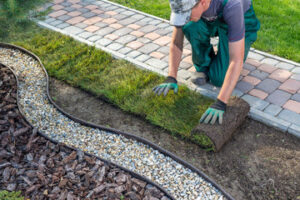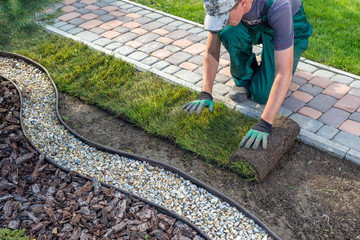Having lush, green grass requires the proper conditions. Start with a clean yard by removing debris, raking and mulching.
Water your lawn correctly by scheduling a time that aligns with your soil type and climate. Use a deep soaking once a week to reduce evaporation and encourage deeper root growth. Contact PristineCutsLawnCare for professional help.
A lawn that is properly maintained and mowed is a foundation of good landscape health. A lawn needs to be mowed at the proper frequency and height for its grass type, growth pattern and season. If mowed too high, it can lead to fungus and other diseases, as well as creating an environment for outdoor pests. It’s also important to regularly empty grass clippings from the mower bag so that they don’t build up on the lawn and smother it, and to mow in straight lines rather than in circles.
In addition to mowing, lawn care includes other cultural practices that help maintain a healthy and beautiful landscape. These include aerating, fertilizing and watering. In order to know how often and what types of fertilizers to apply, a soil test should be completed to see the characteristics of the grass and soil.
For example, a sandy soil will hold on to water but be more susceptible to drought. A clay soil on the other hand holds water but can become compacted and limit air space, which is crucial for root growth and nutrient absorption.
Regular aeration will help break up this compacted soil and allow nutrients, water and air to penetrate the soil. It’s recommended to aerate at least twice a year in the fall and spring.
Aerating is a great way to promote and encourage grass growth. It also helps to reduce thatch levels, which can cause problems with mowing and overall landscape health.
Weed control is also an important part of lawn care. Many weeds are easily controlled with regular cultural practices such as mowing and aerating, and with preventative chemical treatments. A professional landscape company will offer a safe and effective weed control program for your property.
As the seasons change, your lawn can be overtaken by a host of insects and pests. These can be damaging to your landscape, and if not addressed promptly, they may spread to other areas of the yard or even home. A professional Bergen County landscape company can provide insect and pest control services using an Integrated Pest Management program that is safe for the environment as well as your garden.
Irrigation
Keeping your lawn healthy and vibrant requires proper irrigation, which is key to deep root growth. It also stimulates a healthy soil environment that’s resilient against pests, diseases, and weeds. Grass thrives in level, well-drained soil in full sun or part shade. It isn’t suited to soil that is soggy or sloped, nor does it tolerate excessive shade or drought. Manual irrigation involves dragging hoses or watering cans around the yard, which can be tedious for large properties or difficult to do consistently. This technique can lead to over or under-watering. Over-watering compacts soil, encourages shallow roots, and promotes fungal growth. Under watering can turn lush green to yellow and kill beneficial microbes.
The best time to water is in the early morning, when cooler temperatures and minimal winds minimize evaporation. Overwatering during the evening can leave the turf damp overnight and increase disease activity, especially for lawns prone to fungal diseases. Irrigation management is especially important during the summer, when hot weather and less frequent rainfall can place your lawn under stress. It is essential to have a comprehensive irrigation strategy that can adapt to changing conditions throughout the growing season.
A well-designed irrigation system irrigates the entire lawn evenly and effectively. In addition, it is environmentally responsible by reducing nutrient runoff and overwatering that contribute to drought and flood stress in our climate. The right system is also a good investment that will save you time and money in the long run.
Proper mowing, fertilization, and soil testing are also important to a healthy lawn that is able to withstand drought and other climate conditions. Use slow-release fertilizers that provide a consistent supply of nutrients without oversaturating the soil. Aerate your lawn regularly to avoid soil compaction, and keep it weed-free by incorporating native plants that are adapted to local conditions and aren’t easily out-competed by unwanted species. Integrated Pest Management (IPM) strategies that rely on monitoring, preventative measures, and cultural practices reduce the need for chemical pesticides and foster a healthy ecosystem that can better tolerate drought.
Fertilization
Lawns are a focal point of many home landscapes. Some people are still striving for that lush, weed-free lawn; others prefer a more natural look with native plants or low maintenance grasses. Whatever your goals, your lawn needs regular care and attention to thrive. Grass requires a certain amount of water and fertilizer to grow well, but the amount needed depends on many factors, including soil type and sun/shade conditions. A soil test is the best way to determine the amount of organic material, such as compost or manure, and synthetic or slow-release fertilizer required.
A soil test can also help you decide how often and what kind of fertilizer to use. A low-maintenance program may require fertilizing 0 to 2 times per season at annual N rates of 0 to 2 pounds per 1000 square feet; a moderate-maintenance program would include applications of fertilizer with an N rate of 2 to 3 pounds per 1,000 square feet.
Using a lawn spreader, apply your fertilizer to the lawn according to the label directions. One deep watering a week is better than multiple shallow waterings, since deep watering allows the water to soak in more thoroughly and does not encourage the growth of fungus.
Watering at night, on overcast days or early in the morning is also preferable to watering during the day, as it reduces the risk of fungus and promotes deeper soil moisture levels. Avoid overwatering, however, as excess moisture can lead to root rot and plant diseases.
Diseases can damage or even kill healthy turfgrass. Proper mowing, aerating the soil and keeping the lawn free of debris are the first lines of defense against turfgrass diseases. If these efforts are not enough, the use of disease preventative or curative treatments may be necessary.
In addition to the diseases that affect turfgrass, many outdoor insects can cause damage to the lawn. Proper lawn care practices can help keep insect populations under control, but in some cases high infestations can overwhelm a healthy lawn. The most troublesome pests include grubs, sod webworms, billbugs and chinch bugs.
Weed Control
Weeds are unwanted plants that compete with desired grass for water, sunlight, and nutrients. They can be annual or perennial, and they grow in a wide variety of environments and climates. Weeds can be broadleaf, such as dandelions or clover, or grass-like, such as crabgrass or poa annua.
Several strategies can be used for weed control. The best approach is to prevent them from growing in the first place, and this can be achieved by incorporating practices that promote healthy turf that naturally suppresses weed growth. Regular mowing, proper irrigation, and consistent fertilization will help to keep weeds at bay. Other preventative measures include using a pre-emergent herbicide in the fall to kill existing weeds and to stop them from coming back next year.
It’s also important to apply a post-emergent herbicide later in the season, once the weeds have already sprouted. This will remove them, and it’s a good idea to use a targeted weed killer so that you don’t damage your desirable grasses.
Another option for weed control is mulching, which works by covering the soil with a layer of organic material that prevents light from reaching the weeds and inhibits their growth. However, this strategy is not very effective for large weed infestations and can be difficult to maintain over time.
The simplest way to fight weeds is to pull them by hand when they’re small, but this can be very time consuming and requires a lot of effort. Another alternative is to use a natural weed control product, which contains ingredients like corn gluten that hinder root formation and kills the weeds in one application.

